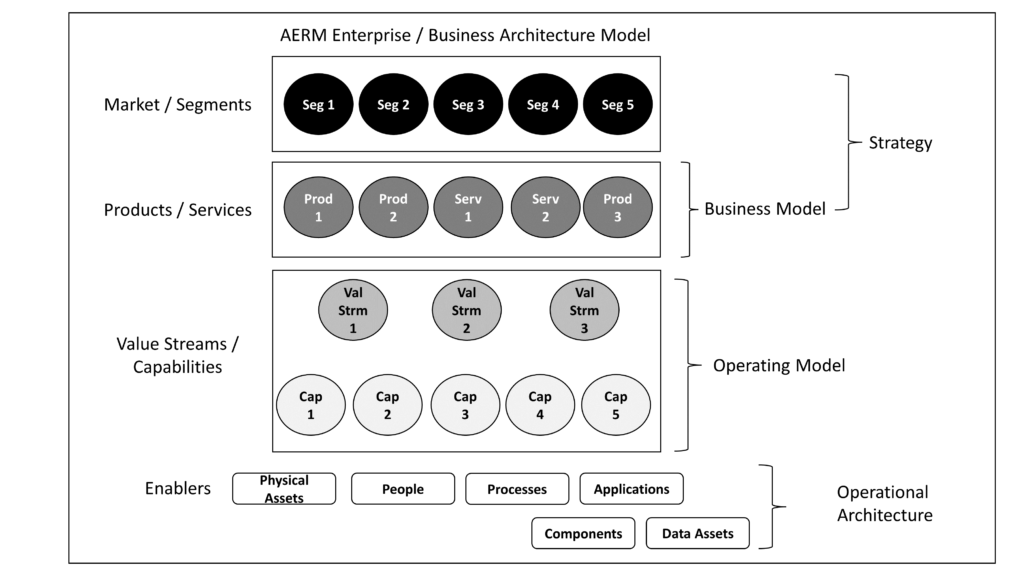Introduction
In this series of articles, I will examine how strategy should inform transformation efforts and how learning how to transform is a critical element of your business’ evolution. An important consideration in all of this is the need to invest in preventing technical and other forms of debt, as they will impede your ability to transform and thus maintain your business agility.
Three Models of Your Company
A Logical model of your company consists of four layers, each of which addresses a unique set of relevant concerns: the Business Strategy, the Business Model, the Operating Model and the Operational Architecture.
The Enterprise Architecture model (the EA Model,) which is the foundation of Agile ERM, is an anatomical model that contains a palette of ten entity types: Markets/Segments, Products/Services, Value Streams, Capabilities, Enablers, Assets (can be Intellectual or Physical,) People, Processes, Applications (which consist of Components and Data Assets.)
Elements of the EA model map almost one to one to the layers of the Logical model. Graphically, the relationships appear in the diagram, below:

The relationship among these layers and elements is summarized in this table:
| Logical Model Layer | Relevant Concerns | EA/BA Model Elements |
| Business Strategy | To whom do you expect to be selling and what is the value proposition that you will offer? Who are the major competitors that you will have to account for and what is their value proposition? | Market Segments, Product and Service characteristics |
| Business Model | What specifically will you offer and to whom will it be targeted? | Products and Services targeted to specific Market Segments |
| Operating Model | How will you structure your company to produce and deliver the value that you will offer? | Value Streams, Capabilities |
| Operational Architecture | How will you structure and equip yourself to create the value? | Capabilities, Enablers |
In other articles and in my book, I’ve made the case that you need to transform yourself into a Digital Company. A company with a Digital Architecture designed to exploit digital technologies has an Operating Model and Operational Architecture consisting of six pillars: the Operational Infrastructure, API Management, the Digital Products and Services Factory, the Partner Development Platform, a set Business Intelligence and Analytics capabilities and a Distributed Governance Model.
This Digital Architecture is shown in the diagram, below:

What are these pillars and how are they implemented? They are composites of multiple EA entities—most of them, Capabilities or Enablers. For instance, the Digital Products and Services Factory (DPSF) is a Capability composed of integrated product management and technology teams (Enablers,) supported by software development tools (Enablers) and processes (also Enablers) intended to accelerate iterative delivery of Products and Services to the company’s Markets. In aggregate, it is the Capability to develop, implement and evolve digital products and services at speed, a very important one.
The Distributed Governance Model is an Enabler, also an important one. It is a set of processes (Enablers) and organizational entities (Enablers) that empowers your company to delegate authority to make product and business decisions to people closest to where they need to be made, while retaining control over issues that are important to your enterprise, such as regulatory compliance. It is intended to facilitate accelerated decision-making by eliminating unnecessary layers of review and approval.
These pillars can be mapped onto the layers of the EA model, though some appear in more than one layer:
| Layer | Model Elements |
| Strategy | Business Intelligence and Analytics |
| Business Model | Digital Products and Services Factory, Business Intelligence and Analytics |
| Operating Model | Digital Products and Services Factory, Partner Development Platform, Business Intelligence and Analytics, Distributed Governance Model |
| Operational Architecture | Operational Infrastructure, API Integration and Management |
Reconciling the Models
So, how do we reconcile these models? They appear not to be properly related and, in fact, they aren’t. Elements of some of the pillars appear in multiple layers of the EA model and various elements of the EA model are shared among hierarchies supporting multiple, potentially disparate, Markets and Products and Services.
Completeness is an important consideration—if you are developing a new product at the same time as you are building the plant where it will be produced, you cannot attain the strategic objective of releasing the product until both have reached a minimum level of completion. Similarly, you cannot realize the benefit of accelerated product evolution fully until you have implemented all of the elements of the Digital Products and Services Factory (the DPSF.) Defining the DPSF as the sum of its required Capabilities and Enablers ensures that you can plan for a pillar that will efficiently and effectively deliver the entire set of Capabilities envisioned for it. However, you can certainly realize some of the benefits by implementing a minimum viable set of its Capabilities and Enablers.
So, you can’t wait around for everything to be completed before you begin to make the changes that will make your company sustainable. When you look at it, doing all of the work required to implement a pillar may well appear to burden efforts to get Products and Services to market with unnecessary overhead. That may be the case in the short term, but taking the longer view is required. Presumably, the Capabilities you are building will enable you to accelerate the development and evolution of many products and services going forward.
What is transformation?
- Adding, making changes to or deleting EA entities, e.g.,
- Product: creating a new product line or adding digital services to an existing one,
- Capability: developing the ability to experiment and evolve prospective products and services at speed,
- Enabler: Adopting Agile, DevOps and CI/CD practices,
- Enabler: Automating a business process or
- Enabler: Acquiring new production equipment.
Digital Transformation is transformation enabled by or intended to exploit digital technologies:
- Focus on Digital Products and Services
- Application of technology to enable and/or enhance characteristics of Products or Services or the performance of Capabilities
- Increased communication and collaboration options, both internally and externally
- Being ‘data-driven’, application of AI
In the previous articles in this series, I looked at the need for digital transformation and agile ERM and the need to develop and evolve your ability to transform at increasing speed.
Some basic facts:
- Architectural discipline, properly managed, can have a positive cost/benefit in two ways:
- Minimizing technical and other forms of debt,
- Creating artifacts that are more reusable, more maintainable, have a lower Total Cost of Ownership (TCO) over their useful lives and which, ultimately, can accelerate the realization of new applications and functionality.
- Such discipline requires some level of centralization.
- Rationalized enterprise-level information infrastructure
- KM, taxonomy
- Change Management
- EA and BA models
- Value-stream product management practices, integrated business and technology teams, a distributed governance model
- BPM and process automation tools, hybrid workforce management approaches
- You will have to balance the costs and risks of change with the need to generate profit from your business in the near term and deal with the complications of delivering in an increasingly fast-paced and fluid environment.
- You’re going to have to figure out how to transform while you’re running the show.
- Technical, process and organizational debt can impair your performance and transformational goals. Learning how to transform while minimizing debt your great challenge.
You need to set goals:
Strategy:
- Types: Cost leadership, Differentiation; both on a wide and focused scale.
- Porter’s 5 Forces (rivalry among competitors, bargaining power of suppliers, bargaining power of customers, threat of substitute products, threat of new entrants)
- It mainly boils down to your value proposition—what are you selling and what does it cost?
- Product strategies—there are many and you need to position yourself
Transformation:
- What should you prioritize to meet your strategic goals?
- Depends on where you are in your markets. Ex Honda-Acura, Hyundai-Genesis
- SWOT—with whom are you competing, what do they have that you don’t and vice-versa?
- What is the rate of evolution within the markets in which you compete?
- Of the 6 digital pillars, what should come first?
- Processes—what do you need to learn to do?
Measurement:
- How will you measure the progress success of your strategy?
- . . . your transformation?
- . . . how the two interact?
From these you will get a better idea of your ability to transform at speed. Why is this important?
- You should plan your strategic initiatives in conjunction with your ability to implement the Capabilities and Enablers required to support them.
- Some will require evolution, and some will require transformation. Inability to transform at speed will become a limitation.
